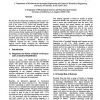Free Online Productivity Tools
i2Speak
i2Symbol
i2OCR
iTex2Img
iWeb2Print
iWeb2Shot
i2Type
iPdf2Split
iPdf2Merge
i2Bopomofo
i2Arabic
i2Style
i2Image
i2PDF
iLatex2Rtf
Sci2ools
ICRA
2000
IEEE
2000
IEEE
A Robotic Stepper for Retraining Locomotion in Spinal-Injured Rodents
We describe the design and testing of a robotic system to assist locomotion training of spinal-injured rodents. The goal of the system is to control and quantify spatialtemporal patterns of movement and forces during the stance and swing phases of rat locomotion. This approach will allow us to provide varying levels of assistance to limb movement during stepping and to quantify the effects of assistance on step training. Our initial finding was that the rat spinal cord could perform stepping on a virtual treadmill generated by the robot system, with careful design of the virtual environment. Based on the conditions required for this "virtual stepping", we suggest several design principles for robot-assisted rehabilitative step trainers, including devicesfor humans.
| Added | 31 Jul 2010 |
| Updated | 31 Jul 2010 |
| Type | Conference |
| Year | 2000 |
| Where | ICRA |
| Authors | David J. Reinkensmeyer, Wojciech K. Timoszyk, Ray D. de Leon, R. Joynes, Eugene Kwak, K. Minakata, V. Reggie Edgerton |
Comments (0)

